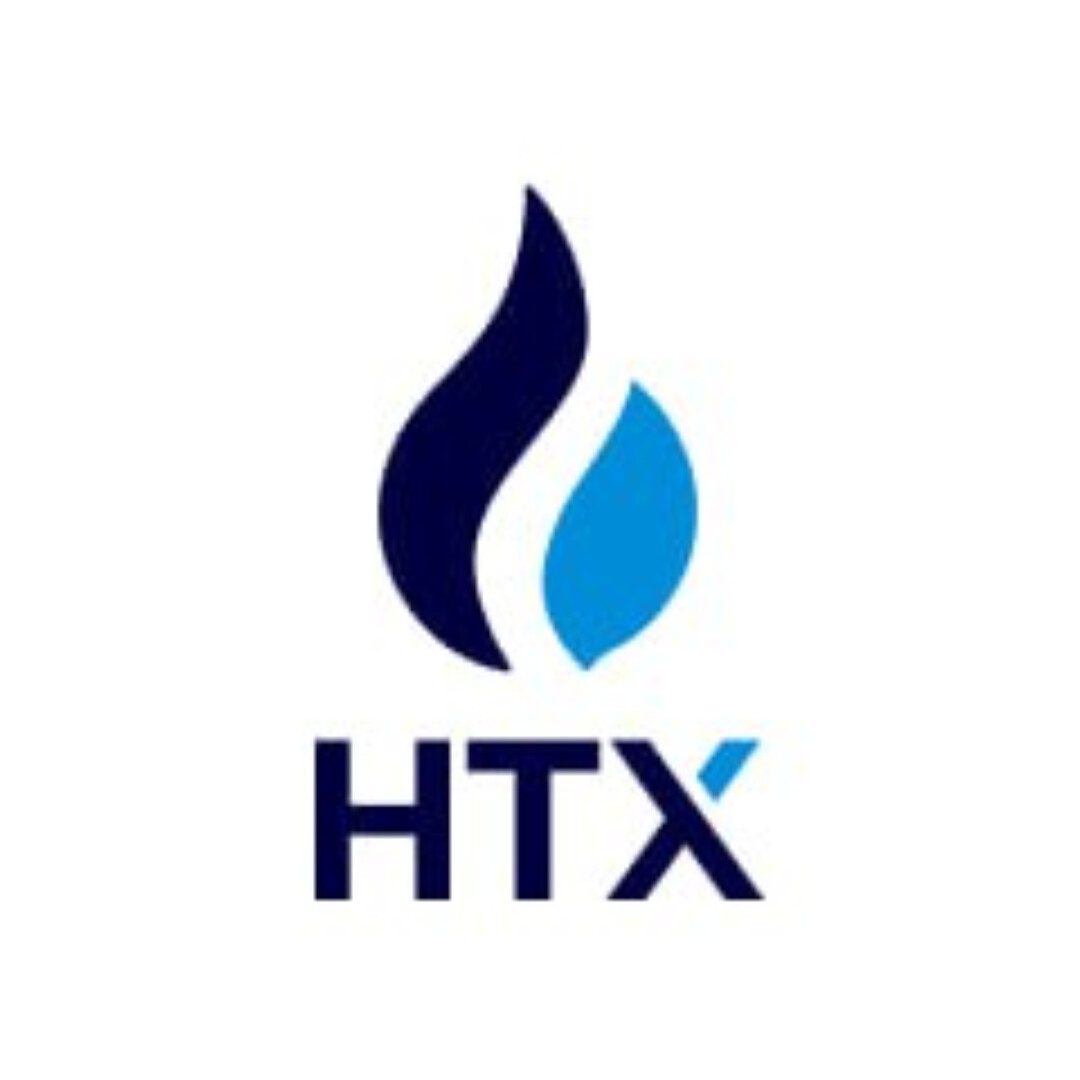Chuyên sâu và giải thích về kế hoạch cải thiện cây Vitalik Merkle và tác động của nó đối với sự phát triển của CEX
tiêu đề cấp đầu tiên
1. Sử dụng phương tiện kỹ thuật để chứng minh khả năng thanh toán
Việc chứng minh rằng một CEX có khả năng hoàn trả các khoản rút tiền của người dùng về cơ bản tương đương với việc chứng minh rằng nó không biển thủ tiền gửi của người dùng. Điều này cần chứng minh một sự bất bình đẳng: tổng tài sản do CEX kiểm soát (bằng chứng về tài sản) >= tổng số tiền gửi của người dùng được sử dụng (bằng chứng về trách nhiệm pháp lý). Ngoài việc công bố hai giá trị này, CEX cũng cần chứng minh rằng các con số ở bên trái và bên phải của bất đẳng thức là đúng, tức là tài sản thuộc về và luôn thuộc về sàn giao dịch, và nó không can thiệp vào số dư tiền gửi của người dùng.
tiêu đề phụ
1.1 Sử dụng cây Merkle để làm bằng chứng trách nhiệm
Cây Merkle là một cấu trúc dữ liệu rất phổ biến trong chuỗi khối. Nó là một cấu trúc cây nhị phân điển hình bao gồm một nút gốc, một tập hợp các nút trung gian và một tập hợp các nút lá. Mỗi nút trung gian cấp cao hơn (nút cha) của cây Merkle là hàm băm của hai nút trung gian (nút con) bên dưới nó và nút gốc cuối cùng thu được thông qua các phép tính từng lớp như vậy. Vì vậy, nút gốc chứa thông tin của tất cả các nút lá. Mọi thay đổi trong dữ liệu cơ bản sẽ được chuyển đến nút cha của nó và được chuyển đến lớp nút gốc theo từng lớp. Nó thường được sử dụng để nhanh chóng chứng minh sự tồn tại hay không tồn tại của một phần tử cụ thể trong một tập hợp, so sánh xem một lượng lớn dữ liệu có giống hệt nhau hay không, tìm vị trí sửa đổi, v.v.
CEX sử dụng cây Merkle để xây dựng ảnh chụp nhanh tập thể ẩn danh và không thay đổi về số dư tài sản tài khoản người dùng, do đó chứng minh rằng họ không can thiệp vào số dư của người dùng. Phương pháp cơ bản nhất là băm tên người dùng/UID của từng người dùng (thêm một số chỉ sàn giao dịch và người dùng biết) cùng với số dư của nó và sử dụng nó làm nút lá để tạo thành cây Merkle. Nếu người dùng thấy rằng gốc Merkle chính xác không thể được tính bằng số dư của chính anh ta và đường dẫn trên cây Merkle, thì có thể xác định rằng sàn giao dịch đã chiếm dụng tài sản của người dùng.
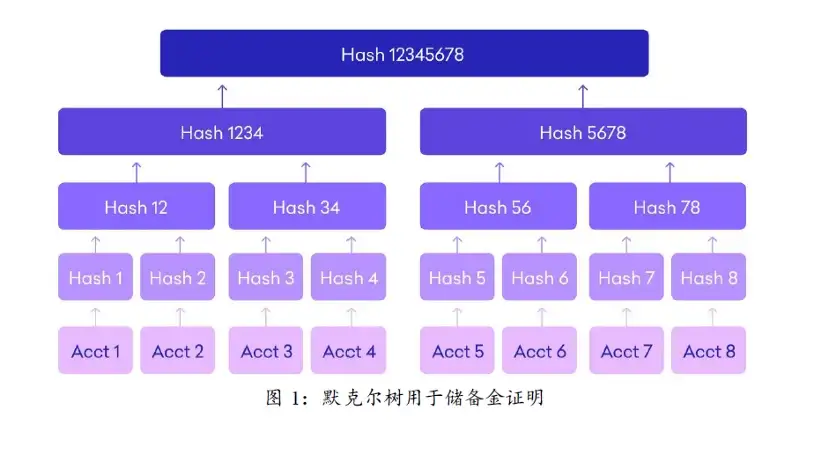
Nhưng như Vitalik đã nói, có một lỗi nhỏ trong cây Merkle nói chung. Vì nó không thể giúp người dùng xác định các giá trị âm, nên nó không thể được sử dụng trực tiếp để chứng minh dự trữ. Như thể hiện trong hình bên dưới, nếu tổng số tiền gửi của khách hàng trên một sàn giao dịch là 1390 ETH, nhưng nó biển thủ 500 ETH, do đó, khoản dự trữ của nó chỉ là 890 ETH. CEX này sẽ thông báo rằng tổng số tiền gửi của người dùng là 890 ETH. Để che đậy hành vi biển thủ tài sản của người dùng, nó có thể thêm một tài khoản giả do chính nó kiểm soát ở đâu đó trong cây với số dư -500 ETH. Sau khi tính toán băm, cho dù đó là số dương hay số âm, sẽ có một chuỗi số rất bất thường, người dùng khác không thể phân biệt được. Cây Merkle thu được bằng cách sử dụng tài khoản giả mạo này sẽ chứa thông tin số dư của những người dùng khác một cách hoàn hảo để kết quả xác minh người dùng luôn chính xác. Các công ty kiểm toán có thể tìm thấy lỗ hổng này, nhưng nếu nó hợp tác với sàn giao dịch để làm điều ác, cây Merkle sẽ trở nên vô dụng.
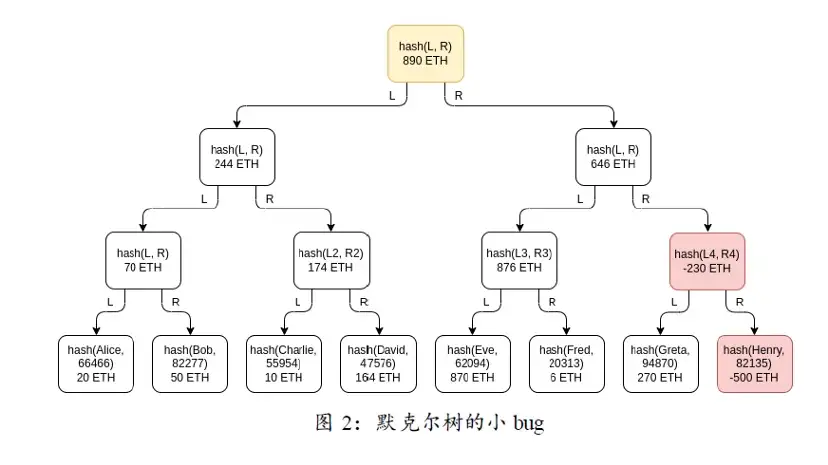
Đối với vấn đề về giá trị âm, Vitalik đã đề xuất một sơ đồ cải tiến có tên là cây tổng Merkle trong bài báo. Mỗi nút của cây tổng Merkle chứa 2 mẩu thông tin, số dư và hàm băm. Các nút lá bên dưới là hàm băm số dư và tên người dùng của mỗi người dùng. Trong mỗi nút cấp cao hơn, số dư là tổng số dư của hai nút bên dưới và giá trị băm là hàm băm của thông tin tổng thể của hai nút bên dưới, nghĩa là số dư và giá trị băm của hai nút được băm với nhau. Hiển thị riêng số dư giúp người dùng xác định các giá trị âm, từ đó vạch trần hành vi chiếm đoạt tài sản của người dùng của CEX. Như thể hiện trong hình trên, Greta sẽ thấy rằng số dư của Henny là âm khi thực hiện tự xác minh; cả Eve và Fred sẽ thấy rằng tổng số dư của Greta và Henny là âm. Điều này sẽ khiến 3 người trong số họ không xác minh được.
Sau khi chuyển đổi, quá trình trao đổi sử dụng cây Merkle để phát hành chứng chỉ dự trữ như sau.
● Tạo bằng chứng cây Merkle: Sàn giao dịch ủy quyền cho một công ty kiểm toán bên ngoài hoặc chính nó chụp nhanh tất cả số dư của người dùng, sau đó tổng hợp chúng thành một cây tổng hợp Merkle.
tiêu đề phụ
1.2 Sơ đồ cải tạo cây Merkle
Việc sử dụng cây Merkle để chứng minh số dư của người dùng vẫn có một nhược điểm nhỏ, đó là nó sẽ làm lộ quyền riêng tư. Như thể hiện trong hình bên dưới, khi Charlie tự xác minh, CEX phải cho anh ta biết số dư của David, tổng số dư của Alice và Bob cũng như tổng của tất cả số dư người dùng ở nửa bên phải của cây. Mặc dù người dùng sẽ không (ít nhất là có vẻ như họ sẽ không) thực hiện các hành vi có hại sau khi biết thông tin này, nhưng đối với các sàn giao dịch và người dùng có số dư bị lộ, việc tiết lộ quyền riêng tư không phải lúc nào cũng là điều dễ chịu.

Để giải quyết vấn đề này, BitMEX đã đề xuất một giải pháp đơn giản. Họ chia ngẫu nhiên số dư tài khoản của người dùng thành nhiều phần, sau đó điền ngẫu nhiên từng phần vào một nút lá dưới cùng của cây Merkle. Số dư người dùng được hiển thị theo cách này chỉ bị phân mảnh, điều này có thể làm giảm bớt các vấn đề về quyền riêng tư ở một mức độ nhất định. Ví dụ như Fred trong hình, tài khoản của anh ấy được chia thành hai phần và Charlie không biết anh ấy có bao nhiêu tiền gửi. Chỉ là nếu ai đó thực sự muốn lấy thông tin của người khác thông qua nhiều tài khoản, anh ta cần phải nỗ lực nhiều hơn, nhưng vẫn có thể làm được.
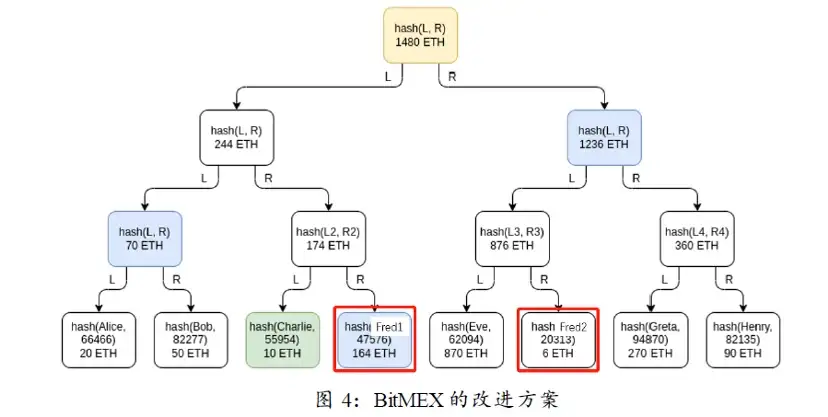
tiêu đề phụ
1.3 Tóm tắt và thiếu sót của các kế hoạch khác nhau
Ở đây, trước tiên chúng tôi tóm tắt và so sánh cây tổng Merkle cơ bản, lược đồ BitMEX, cây ZK-SNARK Merkle và cam kết đa thức KZG, như trong bảng bên dưới. Hai phương pháp đầu tiên rất đơn giản để vận hành, mặc dù có nguy cơ bị lộ quyền riêng tư, nhưng có vẻ như hiện tại không có mối nguy hiểm tiềm ẩn lớn nào và chúng đủ để áp dụng thực tế. Trong hai phương pháp sau, ZK-SNARK được sử dụng để chứng minh phép tính bổ sung, điều này sẽ mang lại các hoạt động bổ sung cho sàn giao dịch, do đó làm tăng chi phí hoạt động. Phương pháp cam kết đa thức KZG tiên tiến hơn, nhưng quá trình tính toán cam kết trao đổi tiêu tốn rất nhiều tài nguyên và liên quan đến một số lượng lớn các phép tính điểm đường cong elip, vì vậy nó có thể không được áp dụng trong thời điểm hiện tại. Tất cả các phương pháp trên không yêu cầu người dùng phải tìm kiếm và dễ dàng xác minh.
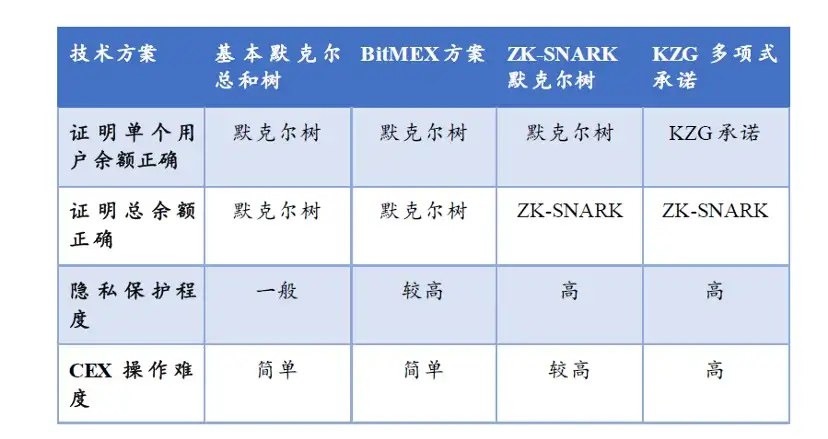
Các giải pháp kỹ thuật để chứng minh trách nhiệm pháp lý và kế hoạch được sử dụng phổ biến hơn để chứng minh tài sản vẫn chưa giải quyết được các vấn đề sau:
Đầu tiên, các kế hoạch chứng minh nợ này yêu cầu người dùng giám sát, nhưng nếu có quá ít người dùng tự xác minh thì sẽ không đủ để kiểm tra hành vi nguy hiểm của sàn giao dịch. Cần tiếp tục giáo dục người dùng và nâng cao nhận thức của người dùng. Một phương pháp khác là giám sát lẫn nhau giữa các sàn giao dịch. Các sàn giao dịch lớn có thể đăng ký một số tài khoản nhất định với các sàn giao dịch khác và ký gửi một lượng nhỏ tài sản để xác minh bằng chứng về trách nhiệm pháp lý của họ.
Thứ hai, cả giấy chứng nhận tài sản và giấy chứng nhận trách nhiệm đều không phải là giấy chứng nhận thời gian thực. Sàn giao dịch có thể lấy tiền thông qua việc vay mượn trước khi làm giấy chứng nhận tài sản, thanh toán cho việc kiểm tra và sau đó trả lại. Có hai cách để giải quyết vấn đề này, một là thống nhất thời gian cố định và tất cả các sàn giao dịch lớn sẽ tiến hành kiểm toán cùng một lúc, hai là tiến hành kiểm toán đột xuất không theo lịch trình. Cả hai phương pháp này đều có thể rút ngắn thời gian cho vay vốn.
Thứ ba, quy trình chứng minh dựa vào công ty kiểm toán đáng tin cậy, nhưng nếu công ty kiểm toán thông đồng với sàn giao dịch, tất cả các biện pháp kỹ thuật sau đó sẽ không có giá trị.
tiêu đề cấp đầu tiên
2. CEX bán tập trung
Các bằng chứng khác nhau được đề cập ở trên được sử dụng để chứng minh rằng CEX không làm điều ác, nhưng CEX vẫn có khả năng làm điều ác. Nếu chúng ta tiến thêm một bước và sử dụng các ràng buộc kỹ thuật để làm cho sàn giao dịch từ không làm điều ác thành không thể làm điều ác, thì niềm tin của người dùng sẽ được khôi phục hoặc thậm chí được nâng cao và hệ sinh thái mã hóa sẽ thịnh vượng hơn.
Vitalik chia các sàn giao dịch thành 5 loại tùy theo mức độ kiểm soát tiền của người dùng và sự thuận tiện khi làm điều ác. Các sàn giao dịch hiện nay chủ yếu là 3 loại. Loại trao đổi đầu tiên từ bên trái trong hình bên dưới kiểm soát hoàn toàn tiền của người dùng và không có biện pháp nào để giám sát và ngăn chặn nó biển thủ tiền của người dùng. Trước cơn bão FTX, hầu như tất cả các CEX đều như thế này. Hầu hết các CEX ngày nay là Loại 2, nơi các sàn giao dịch kiểm soát tiền của người dùng nhưng có sự kiểm soát của con người bên ngoài để giám sát chúng. Hầu hết các DEX thuộc loại 5, trong đó các sàn giao dịch hoàn toàn không kiểm soát tiền của người dùng, vì vậy họ không có khả năng làm điều xấu.

V God đã chỉ ra rằng CEX và DEX không phải là đối lập nhị phân. Giữa tập trung hoàn toàn và phi tập trung hóa hoàn toàn, có một nền tảng trung gian là CEX bán tập trung. Họ có thể kế thừa hệ thống giao dịch hiệu quả cao của các sàn giao dịch tập trung truyền thống và phi tập trung hóa sức mạnh của các sàn giao dịch như người nắm giữ khóa cá nhân đa chữ ký và người xác minh, do đó làm giảm khả năng sàn giao dịch làm điều ác. Chúng là loại trao đổi thứ 3 và thứ 4 trong bài viết của V God.
Trao đổi Loại 3 vẫn có quyền giám sát tiền của người dùng, nhưng nó không thể hoạt động khi mất khả năng thanh toán. Trao đổi như vậy vẫn chưa xuất hiện. Nếu nó được thực hiện, cần phải đặt ra một số hạn chế đối với nó. Đây là một chút trí tưởng tượng, bạn có thể yêu cầu CEX lưu trữ nội dung trong một số địa chỉ được kiểm soát đa chữ ký cố định hoặc sử dụng công nghệ MPC để chia khóa riêng thành nhiều bản sao. Theo dõi trạng thái của các quỹ trao đổi thông qua kiểm tra khả năng thanh toán theo thời gian thực hoặc tần suất cao. Trong các trường hợp bình thường, chỉ cần có khóa riêng do chính CEX kiểm soát để hoàn tất chữ ký chuyển tiền. Nếu phát hiện vốn mất khả năng thanh toán/tỷ lệ chuyển khoản một lần quá cao/chuyển khoản liên tục, v.v., những người nắm giữ khóa cá nhân khác có thể kích hoạt chế độ khẩn cấp và cùng nhau từ chối giao dịch để đạt được hiệu quả đóng băng tài khoản. Phương pháp này sử dụng nhiều người nắm giữ khóa riêng để giảm mức độ tập trung của CEX, do đó làm giảm sự thuận tiện khi làm điều ác. Những trao đổi như vậy có thể là hướng phát triển của CEX trong tương lai.
Nếu loại hình trao đổi này tiếp tục phát triển, nó cần phải đưa công việc kiểm toán lên một tầm cao hơn. Độ tin cậy, tốc độ và tự động hóa của các cuộc kiểm toán trong tương lai cần được cải thiện để đáp ứng nhu cầu của các sàn giao dịch này.
tiêu đề cấp đầu tiên
3. Học hỏi từ tài chính truyền thống
Như Wilson, một nhà phân tích tại X Research DAO,trong văn bảnNói cách khác, các sàn giao dịch tiền điện tử tập trung ở giai đoạn này có những nhược điểm như thẩm quyền nội bộ quá mức, lưu ký tài sản không rõ ràng, khuếch đại thu nhập bốc đồng và không có ràng buộc bên ngoài. Để giải quyết những vấn đề này, dựa vào tiến bộ công nghệ chỉ là một con đường và con đường còn lại là thiết lập một bộ sắp xếp thể chế hợp lý để phân chia và hạn chế quyền hạn của CEX.
Thị trường tiền điện tử hiện tại rất giống với giai đoạn hoạt động hỗn hợp của ngành tài chính sơ khai. CEX là một tổ chức toàn diện tích hợp nhiều chức năng tài chính khác nhau. Một mặt, nó cung cấp ủy thác và đối sánh giao dịch tại chỗ, đồng thời có toàn quyền quản lý các loại tài sản mã thông báo khác nhau (bao gồm cả tài sản tiền tệ ổn định) do khách hàng nạp lại, đồng thời cung cấp nhiều loại tài chính khác nhau. dịch vụ quản lý. Nhiều doanh nghiệp cũng có nghĩa là nhiều khu vực pháp lý và khi một tổ chức có quá nhiều quyền lực, vấn đề chỉ là liệu nó có sử dụng nó cho lợi ích cá nhân hay không.
Trong giai đoạn tiếp theo của thị trường mã hóa, chắc chắn sẽ cần phải xây dựng một mô hình giao dịch an toàn hơn, đó là một lối tắt để học hỏi từ hệ thống ngành chứng khoán đã được kiểm chứng và cải tiến qua thực tiễn hàng thập kỷ. Ngành chứng khoán đã hình thành hệ thống giao dịch chuẩn hóa, bao gồm:
Tổ chức lưu ký bên thứ ba (ngân hàng thương mại) gửi tiền thanh toán giao dịch của khách hàng.
Việc đăng ký, lưu ký và thanh toán chứng khoán do các tổ chức đăng ký và thanh toán chứng khoán thực hiện tập trung.
Công ty môi giới chứng khoán nhận ủy thác của khách hàng, thay mặt khách hàng mua, bán chứng khoán, cung cấp các dịch vụ tài trợ và cho vay chứng khoán.
Việc khớp lệnh tại chỗ thông tin giao dịch được hoàn tất bởi sở giao dịch chứng khoán.
Thông qua hệ thống phối hợp đa bên và kiểm tra cân bằng như vậy, ngành chứng khoán đã tránh được rủi ro hệ thống do một tổ chức duy nhất làm điều ác gây ra. Bốn chức năng trên đều được hoàn thành bởi CEX, điều này làm tăng đáng kể nguy cơ lỗi một điểm. Do đó, cần kết hợp các đặc điểm của giao dịch tài sản mã hóa, học hỏi từ mô hình kinh doanh tài chính truyền thống và để nhiều tổ chức độc lập đảm nhận các chức năng khác nhau của trao đổi tiền điện tử hiện tại, để đạt được sự phân cấp và kiểm tra và cân bằng.
Loại tài liệu tham khảo này không hề dễ dàng và nó có những khó khăn sau:
Tách hoạt động đồng nghĩa với việc CEX được giao nhiều quyền hạn, điều này có thể làm giảm khả năng sinh lời của nó, vì vậy bản thân CEX không sẵn sàng làm như vậy.
Điều này đòi hỏi sự can thiệp của cơ quan quản lý, nhưng cách xây dựng các quy tắc vẫn cần được khám phá và việc đưa ra các luật và quy định rất tốn thời gian.
Các quy tắc quản lý của các quốc gia khác nhau có thể không nhất quán và không rõ liệu điều này có dẫn đến sự phân mảnh của thị trường mã hóa hay không.
Nhiều ràng buộc về thể chế hơn cũng có nghĩa là có thể có chi phí quản lý cao hơn và những chi phí này sẽ được chuyển cho người dùng.
Người giới thiệu
Người giới thiệu
1. https://www.odaily.news/post/5183267
2. https://vitalik.ca/general/2022/11/19/proof_of_solvency.html
3. https://www.kraken.com/zh-cn/proof-of-reserves
4. https://www.odaily.news/newsflash/304869
5. https://www.okx.com/proof-of-reserves
7. https://blog.bitmex.com/bitmex-pol-system-now-live/
8. https://twitter.com/XResearchDAO/status/1592058023715147779
9. https://www.odaily.news/post/5183328
10. https://m.jinse.com/blockchain/2667533.html
Giới thiệu về viện nghiên cứu Huobi
Viện nghiên cứu ứng dụng chuỗi khối Huobi (gọi tắt là "Viện nghiên cứu Huobi") được thành lập vào tháng 4 năm 2016. Kể từ tháng 3 năm 2018, viện đã cam kết mở rộng toàn diện nghiên cứu và khám phá trong các lĩnh vực khác nhau của chuỗi khối, với mục tiêu pan-blockchain là đối tượng nghiên cứu, mục tiêu nghiên cứu là đẩy nhanh nghiên cứu và phát triển công nghệ chuỗi khối, thúc đẩy ứng dụng của ngành chuỗi khối và thúc đẩy tối ưu hóa sinh thái của ngành chuỗi khối. Nội dung nghiên cứu chính bao gồm xu hướng ngành, lộ trình kỹ thuật, đổi mới ứng dụng, Khám phá mẫu, vân vân. Theo các nguyên tắc phúc lợi công cộng, nghiêm ngặt và đổi mới, Viện nghiên cứu Huobi sẽ thực hiện hợp tác sâu rộng và sâu rộng với các chính phủ, doanh nghiệp, trường đại học và các tổ chức khác thông qua nhiều hình thức khác nhau và xây dựng một nền tảng nghiên cứu bao gồm chuỗi công nghiệp hoàn chỉnh của blockchain.Các chuyên gia trong ngành cung cấp nền tảng lý thuyết vững chắc và phán đoán xu hướng để thúc đẩy sự phát triển lành mạnh và bền vững của toàn bộ ngành công nghiệp blockchain.
liên hệ chúng tôi:
Email tư vấn: research@huobi.com
Trang web chính thức:https://research.huobi.com/
Twitter: Huobi_Research
https://twitter.com/Huobi_Research
Medium: Huobi Research
https://medium.com/huobi-research
Telegram: Huobi Research
https://t.me/HuobiResearchOfficial
từ chối trách nhiệm
1. Viện nghiên cứu chuỗi khối Huobi không có bất kỳ mối quan hệ nào với các dự án hoặc bên thứ ba khác liên quan đến báo cáo này mà ảnh hưởng đến tính khách quan, độc lập và công bằng của báo cáo.
2. Các tài liệu và dữ liệu được trích dẫn trong báo cáo này đều từ các kênh tuân thủ. Các nguồn tài liệu và dữ liệu được coi là đáng tin cậy bởi Viện nghiên cứu chuỗi khối Huobi và các xác minh cần thiết đã được thực hiện về tính xác thực, chính xác và đầy đủ của chúng, nhưng Huobi Blockchain Viện nghiên cứu không đưa ra bất kỳ đảm bảo nào về tính xác thực, chính xác hoặc đầy đủ của nó.
3. Nội dung của báo cáo chỉ mang tính tham khảo, các kết luận và ý kiến trong báo cáo không cấu thành bất kỳ lời khuyên đầu tư nào đối với các tài sản kỹ thuật số có liên quan. Viện nghiên cứu chuỗi khối Huobi không chịu trách nhiệm cho bất kỳ tổn thất nào do việc sử dụng nội dung của báo cáo này, trừ khi nó được quy định rõ ràng bởi luật pháp và các quy định. Người đọc không nên đưa ra quyết định đầu tư chỉ dựa trên báo cáo này, cũng như không nên đánh mất khả năng đưa ra những đánh giá độc lập dựa trên báo cáo này.
4. Các thông tin, ý kiến và suy đoán trong báo cáo này chỉ phản ánh nhận định của các nhà nghiên cứu vào ngày hoàn thiện báo cáo này, trong tương lai, dựa trên những thay đổi của ngành và cập nhật thông tin dữ liệu, có thể cập nhật các ý kiến và nhận định .
5. Bản quyền của báo cáo này chỉ thuộc sở hữu của Viện nghiên cứu chuỗi khối Huobi, nếu bạn muốn trích dẫn nội dung của báo cáo này, vui lòng ghi rõ nguồn. Vui lòng cho tôi biết trước nếu bạn cần trích dẫn nhiều và sử dụng nó trong phạm vi cho phép. Trong mọi trường hợp, không được trích dẫn, rút gọn và sửa đổi trái với mục đích ban đầu đối với báo cáo này.

